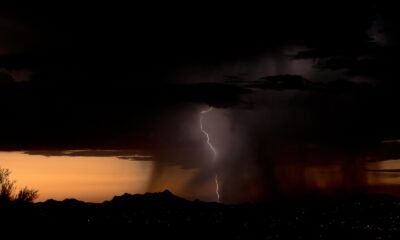arizona
Monsoon Delays Its Arrival Despite Recent Rainfall

The arrival of early June brought scattered storms across Arizona and New Mexico, signaling the anticipated change in weather. For many residents in the Southwest, this thunder and rainfall evoked memories of the summer monsoon season.
However, these early showers do not mark the official start of the monsoon. Understanding the North American Monsoon (NAM) requires recognizing it as a seasonal atmospheric shift, not just isolated storms. Typically lasting from mid-June through September, the NAM dramatically increases moisture and rainfall across the Southwestern United States.
The term “monsoon” originates from the Arabic word “mausim,” meaning “season.” This reflects a persistent change in wind direction and humidity rather than sporadic rain events.
Although Arizona experienced localized thunderstorms in early June, attributed to upper-level disturbances and residual moisture from Tropical Storm Alvin, these rains can’t be classified as monsoonal. True monsoonal conditions depend on a consistent shift that brings moisture-laden air up from the Gulf of California and Mexico. Until such a pattern is established, early rain should be viewed as a precursor rather than the main event.
The National Weather Service no longer sets a specific “start date” for the monsoon season based on dew point temperature. Instead, June 15 serves as a climatological benchmark used for statistical tracking. Meteorologists, however, look for a reliable shift in upper-atmospheric winds and consistent high dew points, typically above 55°F in locations such as Phoenix.
The subtropical ridge, which influences moist air flow, remains variable as of early June. The onset of the monsoon will occur when this ridge stabilizes over the Four Corners region, allowing for sustained moisture influx.
While the early rains may have sparked optimism for a wet season, they don’t guarantee it. Early moisture can create misleading perceptions, especially if followed by extended dry periods. According to the Climate Prediction Center, there is a 33-50% chance of above-average rainfall in Arizona from July to September, though predicting the timing, frequency, and coverage of monsoonal events remains challenging.
Monsoon patterns can be erratic, featuring intense rainfall followed by prolonged breaks or a delayed onset that culminates in a strong finish. The evolution of these patterns throughout the summer will ultimately define the wider weather experience.
In summary, while the early June rains were noteworthy, they did not signal the official commencement of the monsoon. The North American Monsoon entails a comprehensive atmospheric transformation characterized by weeks of humidity, heat, and dynamic weather. Until this broader pattern is established, any early rain remains just that—early.


![Maricopa Planning and Zoning Commission Chair James Singleton sits at the dais with Commissioners Ted Yocum and Robert Klob during a meeting June 9, 2025. [Monica D. Spencer]](https://arizonanews.org/wp-content/uploads/2025/06/Zoning-Board-Divides-Opinion-and-Delays-Decisions-on-Eastside-Housing-400x240.jpg)
![Maricopa Planning and Zoning Commission Chair James Singleton sits at the dais with Commissioners Ted Yocum and Robert Klob during a meeting June 9, 2025. [Monica D. Spencer]](https://arizonanews.org/wp-content/uploads/2025/06/Zoning-Board-Divides-Opinion-and-Delays-Decisions-on-Eastside-Housing-80x80.jpg)














